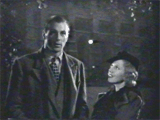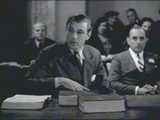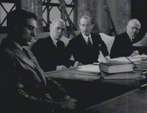|
|
|
What helps to make Capra’s films still vital is that he wasn’t merely proselytizing, he was also exploring the extent to which the values he considered fundamental could still effectively function in modern America. I think that is the crucial campaign Capra waged. He wanted to know the answer to that. As names of two central figures of his Depression trilogy—
 |
Gary Cooper and Jean Arthur at Grant's Tomb in Mr. Deeds Goes To Town.
28.8K |
56K
|
Longfellow Deeds and Jefferson Smith—indicate, Capra’s heroes are composites of the 19th century giver of tradition—Longfellow, Jefferson—with Everyman—Deeds, Smith. Their function in the alien habitat of the big city is summed up by a scene, which many of you know, in the trilogy's opening film Mr. Deeds Goes To Town, (1936). The hard-boiled newspaper reporter, Louise "Babe" Bennett, whose nickname signifies that she has lost her sophistication, become reduced to infancy in the big city, lost her values and everything. Louise Babe Bennett escorts Longfellow Deeds to Grant's Tomb and remarks that most people find it a letdown, a "bust." Deeds responds, "that depends on what they see" and then this small-town hick from Mandrake Falls, Vermont, proceeds to teach the sophisticated Pulitzer Prize-winning reporter how to see, how to read her own history. "I see a small [Ohio] farmboy becoming a great soldier, I see thousands of marching men. I see General Lee with a broken heart surrendering. And I can see the beginnings of a new nation like Abraham Lincoln said. And I can see that Ohio boy being inaugurated as president. Things like that can only happen in a country like America." Scenes like this are repeated throughout Capra's trilogy and contain the essence of his cultural populism. Babe Bennett is drawn back to the small-town innocence and unpretentiousness she, like America itself, has lost. But with the help of unspoiled people like Deeds, Americans could recover and redeem themselves—and redemption is precisely what is at the heart of Capra’s films. As Leonard Quart has remarked, Capra was not concerned with the politics of social restructuring, the politics of revolution, but rather with the politics of conversion and moral regeneration." [Leonard Quart, "Frank Capra and the Popular Front," Cinéaste (Summer, 1977), 6.] Deeds and all but two of his future films," Capra wrote, "embodied the rebellious cry of the individual against being trampled into an ort by massiveness—mass production, mass thought, mass education, mass politics, mass wealth, mass conformity." [Capra, The Name Above the Title, 186.]
This captures the core of Capra’s populism and politics in the Depression. But Capra's populism can’t be summed up quite this simply. There are other elements that help to explain both his appeal and the contours of his career.
 |
Longfellow Deeds gives away his money Mr. Deeds Goes To Town.
28.8K |
56K
|
Capra’s populism is ridden through with a virulent anti-materialism, his heroes care nothing for wealth or status. Deeds' goal is to give away his $20 million inheritance. Jefferson Smith spurns the political pork barrel in favor of building a boys' camp in Montana. John Doe continually tries to escape his fame and influence in favor of resuming his career as a baseball pitcher. George Bailey yearns to escape his life as a banker, in order to travel and see the world. John Raeburn has argued that Capra's injection of this anti-materialism into the traditional American message gave it a new vitality, "a way of looking at middle-class life which does not make it seem banal, sterile, and purposeless, [and] which invests it with vitality and style." [John Raeburn, "Introduction," in Glatzer and Raeburn, eds., Frank Capra.]
Capra’s populism is shot through with patriarchy. As Bob Toplin said, Capra knew how to depict women of independence, power, and dignity. He picked actresses like Barbara Stanwyck and Jean Arthur and Claudette Colbert, who exuded these qualities. But he also knew how to transform them into more traditional feminine roles. Thus, his breakthrough film in the 1930s, It Happened One Night, which most of you have seen, is by Capra’s own testimony a Taming of the Shrew tale. [Capra, The Name Above the Title, 164.] In Meet John Doe one has only to contrast the woman reporter at the beginning and the end of the film to see her transition from a proud, tough professional to a weeping dependent. In Deeds there is the clear intimation that Babe Bennett will give up her profession to follow Longfellow back to his small Vermont town. By the time we get to It’s A Wonderful Life the woman no longer has a career, she remains in the small town as a housewife, and the film tells us that her horrid fate, had her husband never been born, would have been to be a spinster librarian wearing glasses. You may remember that scene, it’s a great scene in that movie.
 |
Longfellow Deeds is silent in Mr. Deeds Goes To Town.
28.8K |
56K
|
Capra’s populism was based not only upon the values of traditional small-town America, but also on its fundamental style and means of communication—oral culture. "Voice," the linguist Walter Ong has written, "has a kind of primacy in the formation of true communities." Capra’s heroes function through the spoken word, while many of his tough, cynical, urban types are people of the written word—newspaper writers and literary snobs, antitheses of the oral hero and values and approach. In each of his films the hero's ordeal is symbolized by his muteness: Longfellow Deeds, deeply depressed and unable to speak on his own behalf at his sanity trial; Jefferson Smith, in constant danger of being silenced by the rules of the Senate; John Doe attempting to address his followers through a dead microphone.
Previous |
Next
Lawrence Levine
Part 1: Capra and the Politics of Culture
Part 2: Capra's Political Populism
Part 3: Capra's Fundamental Values
Part 4:
Pessimism in Capra's Cultural Politics
|



